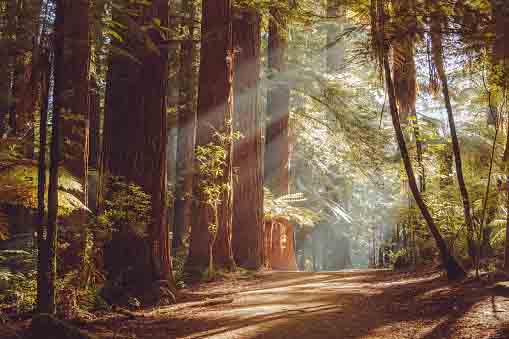Here is complete guide about Coast Redwood Tree found in the book called “TREE AND SHRUB GARDENING FOR NORTHERN CALIFORNIA” by “Bob Tanem” and “Don Williamson”,here is an excerpt from the book
Giant Sequoia
THE STATE TREE OF CALIFORNIA IS SEQUOIA SEMPERVIRENS. Sempervirens translates into ‘ever living,’ which is quite true of this tree’s nature. A walk through some the redwood forests on the coast of Northern California will verify the ability of these trees to survive any disaster. In the Eel River area, you can see areas where the river has deposited 5’ of silt around the redwoods and later washed it away.
These trees merely set out new root systems to adapt. Fire that burns through a forest of coast redwoods may damage the interior of some of these trees-the trunks can be quite hollow, from the ground up to 20’ or so-yet the trees survive and are thriving. Most of this survival is made possible because of the coast redwood’s very thick, fibrous bark.
Growing
Coast redwood grows well in full sun or light shade. The soil should be of average fertility, moist and well drained. Coast redwood needs regular watering for the first few years of growth and when planted in hot, dry areas. In its native habitat, it is able to get water from the ocean fog. Coast redwood does not like pollution or urban environments. Pruning is rarely required.
Tips
Coast redwood makes a stunning specimen tree alone or in groups. Never underestimate its potential size-this giant is not for the average garden. Lack of water in summer slows the tree’s growth. The smaller cultivars can be used as windbreaks, as hedges and in shrub or mixed borders. Plant coast redwoods while they are small enough to not require staking. Seedling-grown Sequoia sempervirens tends to send up sucker-like growth. If the suckers are not removed, they will slow the growth of the central core. Unlike most coniferous trees, redwood sprouts new shoots from the base if cut down.
Coast redwoods grow best in conditions of high atmospheric pressure and humidity at sea level. Giant sequoias (Sequoiadendron giganteum) do best in higher elevations such as Yosemite National Park.
Recommended
Sequoia sempervirens (Coast Redwood) is a tall, columnar or conical tree, with horizontal branches and drooping branchlets. It is native to the northern coastal regions of California. It grows 50-100’ tall and 20-30’ wide in gardens but can grow three times as tall in the wild. ‘Adpressa’ is a smaller, slower-growing cultivar that is hardier than the species, to Zone 6. It grows 20-30’ tall and spreads 10-20’. ‘Aptos Blue’ is similar to the species in growth, but it has dence, blue-green foliage. ‘Prostrata’ is a dwarf, spreading cultivar. It grows 5’ tall and spreads 5-10’.
This cultivar has a tendency to revert to the upright form, so watch for and remove any strongly upright growth. ‘woodside’ and ‘Filoli’ are thought to be the same. Both have intense blue foliage and irregular growth. (Zones 7-10)
Alternate Species
Sequoiadendron giganteum (Sequoia gigantea) (Giant Sequoia, Big Tree) is a large, pyramidal tree that branches to the ground. The foliage is denser and more prickly than coast redwood’s. This tree grows 60-100’ tall and 30-50’ wide in gardens. It prefers moderate watering. It is subject to fungal diseases in humid climates. Giant sequoia is hardier to the cold than coast redwood. Use as a specimen tree in a large setting. It is not tolerant of urban conditions or pollution. The pyramidal shape lends giant sequoia to becoming a living Christmas tree. This tree is very useful as a fire break in the mountains to ward off forest fires. (Zones 6-9; Zone 5, if protected)
Problems & Pests
Redwoods may suffer from iron chlorosis in iron-poor soils. Look for yellowing of the new leaves. Use an iron chelate. The older foliage will naturally turn yellow, then brown and then fall off. Redwood is resistant to oak root fungus.

